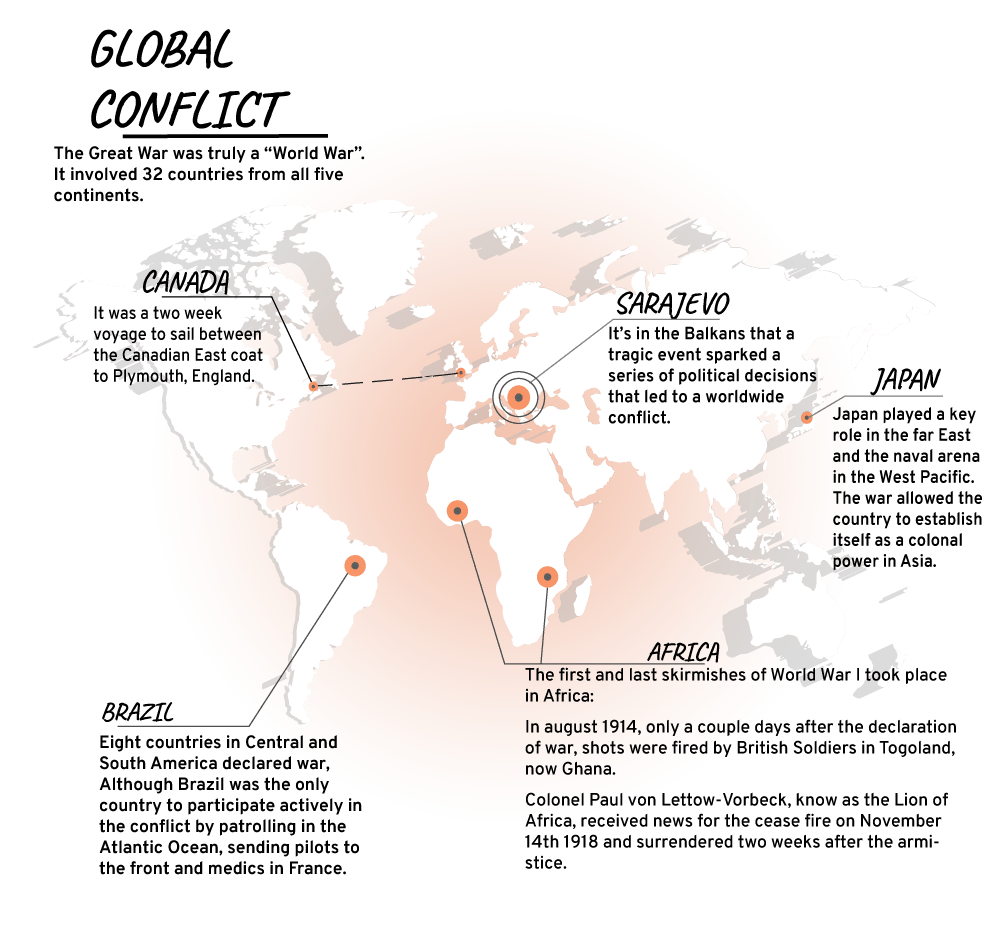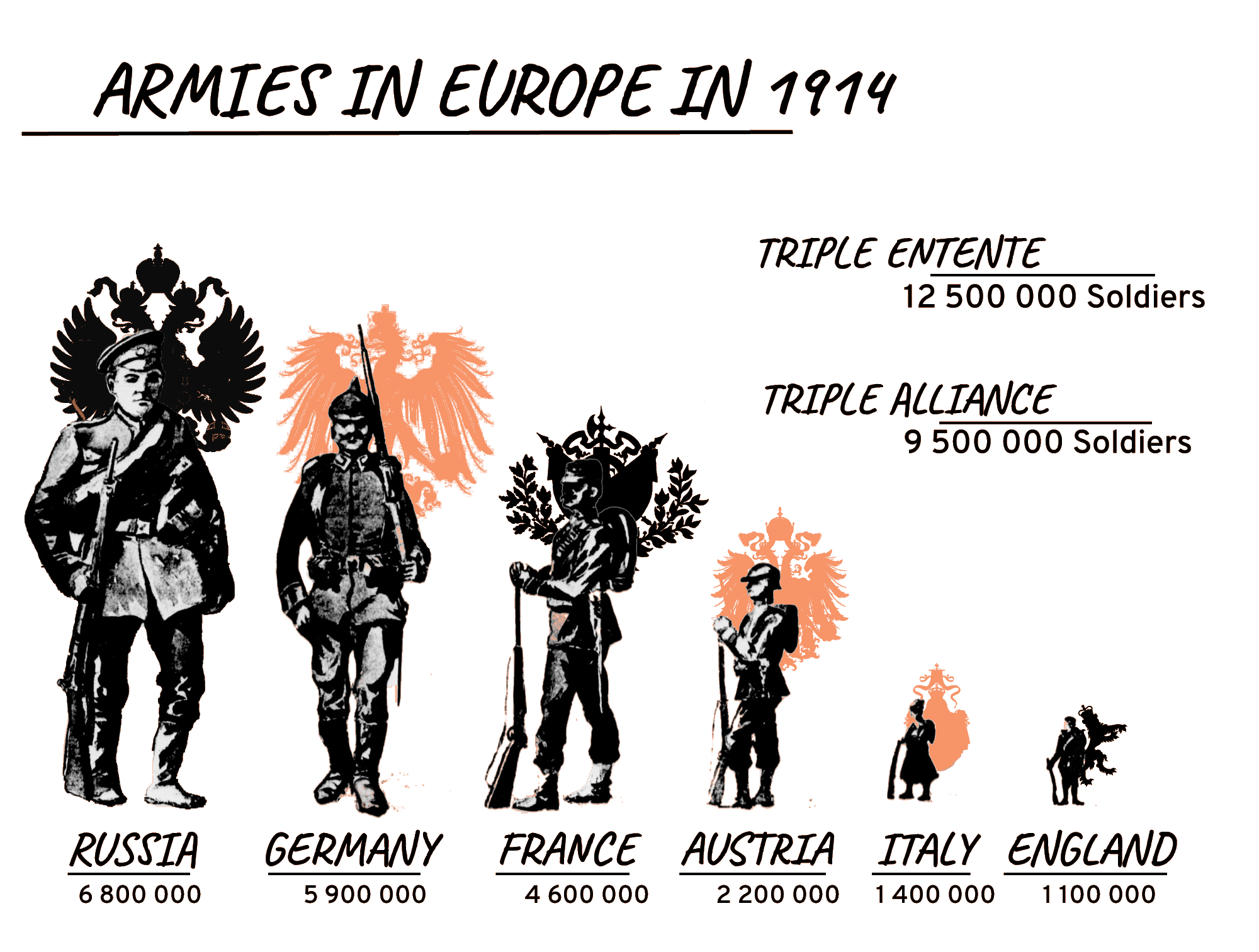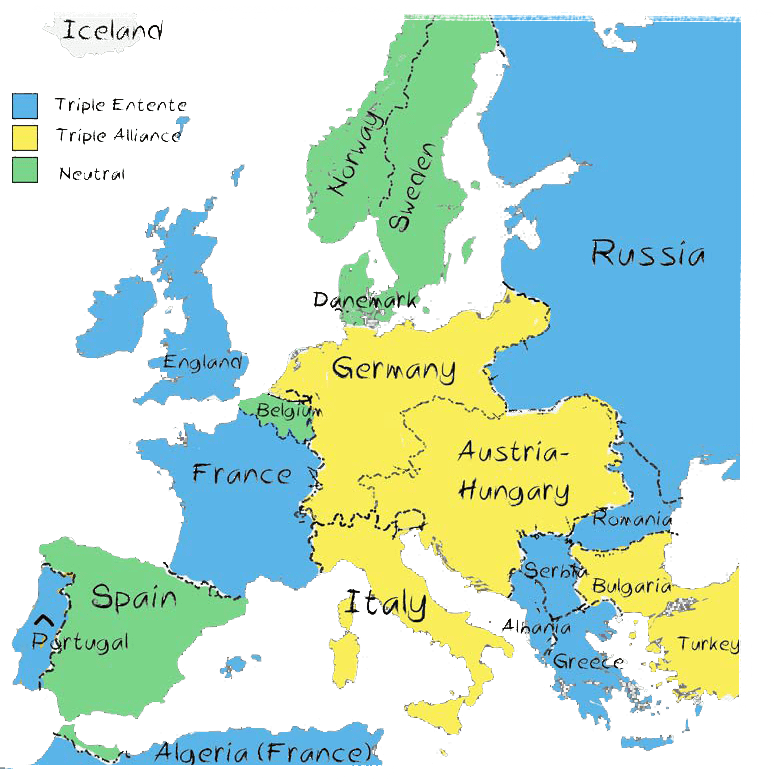War Breaks Out

At the outbreak of war in 1914, no one expected that the conflict would escalate to such a degree or to last for so long. In the years preceding the Great War, the mightiest countries of Europe forged strong alliances with one another in order to maintain the balance of power on the continent. Due to these alliances many countries were bound by treaties to join the conflict , when the Austro-Hungarian Empire declared war on Serbia. Russia’s alliance to the Serbian power forced the country to side against the Austro-Hungarian Empire. Germany had strong ties to the Austro-Hungarian Empire and took its side against Serbia and Russia. Like a domino effect, almost all European countries were pulled into the conflict.
Many European countries were major colonial powers at the time. Their involvement in the conflict therefore meant that their colonies were automatically at war as well. As a result, the Great War involved people from all over the world. Although the fighting mainly took place in Europe, Africa and the Middle-East also saw their own theatres of war. Not only was the Great War a global conflict on a geographical level, but its scale and duration meant that it affected all spheres of society. The entire world economy shifted to accommodate the war effort. Everyone was somewhat involved in the conflict: children were targeted by propaganda which told them to convince their fathers to join the army, women entered the workforce in great numbers, and minority groups enlisted with the hope of gaining better treatment after the war.

A Numbers Game?
During the 19th century and leading up to the First World War, European countries spent considerable resources maintaining an army even in times of peace. Each country had to make sure they would be ready as quickly as possible in case they were attacked. However, the extent to which they prepared for an eventual conflict varied widely.
For example, in terms of numbers, the Russian Empire had the largest army in 1914. Yet, when we compare the number of soldiers to the total Russian population, we realize that only 0.4% of the population was actually trained to participate in the war. In reality, the Russian Empire had the smallest per capita enlistment rate of all the countries listed above. In contrast, France had the largest at 11%.
WWI Background

Many European empires lost their colonies in the Americas during the 1700s and 1800s, yet the Middle East, Africa and Asia were still sought after territories. Decades of imperial rivalries, economic competition, nationalism, and instability following the collapse of the Ottoman Empire in the east all led to a very fragile and unstable peace in Europe at the turn of the 20th century.
The Archduke Franz Ferdinand, who was to become the future King of Austria-Hungary, was assassinated on June 28, 1914 in Sarajevo, Bosnia by a Serbian nationalist. The assassin was part of an extremist group that wanted Serbian power in the Balkans and intended to break up the Austro-Hungarian Empire. Austria-Hungary believed the Serbian government was involved in the murder and declared war. This declaration of war was supported by Germany, an ally of Austria-Hungary.
Russia quickly became involved as it sought to protect Slavic nations (which included Serbia). Germany then stepped in and demanded a promise of peace from Russia and its ally, France. When the Germans received no reply, they declared war on Russia on August 1, 1914, and on France on August 3, 1914.
European countries wrangled one another into two competing alliances at the start of WWI in 1914: The Triple Alliance (Germany, Austria-Hungary, the Ottoman Empire, and Italy, which later left the Alliance) and The Triple Entente (France, Russia, and Great Britain).
On its way to France, the German army invaded Belgium on August 3rd, 1914. Britain, an ally of France and supporter of Belgian neutrality, demanded that the Germans withdraw from Belgium and that Germany observe the Treaty of 1839 which declared Belgium a neutral country. Despite the ultimatum from the British, the Germans continued their invasion and Britain declared war on Germany on August 4th.
Canada was a self-governing Dominion of the British Empire, but did not fully determine or control its own foreign affairs. Therefore Canada was obliged to enter the War alongside Britain, which asked for 25,000 Canadian soldiers to be deployed.
The Canadian Government thought that the might of the British Empire would make for a short-fought war with Germany. Little did they know it would last four long years and enlist 619,636 Canadians, almost 13% of Canada’s population of 8 million.
Ultimately Canada triumphed and showed remarkable fighting strength on the Western Front, contributing to the victory of the Allied nations, but the First World War changed the country forever. The triumph also came at a great cost: nearly 61,000 Canadians died and 172,000 were wounded. Thousands more returned home with psychological wounds inflicted by the war. Then known as “shell shock”, we would now classify these psychological wounds as PTSD (post-traumatic stress disorder).
A total of approximately 9 million people in uniform and 13 million civilians died in the First World War.
Who got involved? When?
Although the war began in Europe, it quickly spread around the world. The following is a of countries, which shows their alliances and the dates they entered the War:
The Triple Entente or Allies
- Serbia (28 July 1914)
- Russia (1 August 1914)
- France (2 August 1914)
- Great Britain (4 August 1914)
- British Empire Dominions and Colonies (4 August 1914):
- Australia
- India
- Canada
- Newfoundland
- New Zealand
- South Africa
- Japan (23 August 1914)
- Italy (23 May 1915)
- United States (6 April 1917)
These countries also fought with the Allies or declared war on the Central Powers:
Minor European Powers:
- Portugal
- Belgium
- Romania
- Greece
- Montenegro
Other countries:
- San Marino
- Brazil
- Costa Rica
- Cuba
- Ecuador
- Guatemala
- Haiti
- Honduras
- Nicaragua
- Panama
- Peru
- China
- Siam
- Liberia
The Central Powers:
- Austria-Hungary (28 July 1914)
- Germany (1 August 1914)
- Turkey (5 November 1914)
- Bulgaria (14 October 1915)
These were the main European countries that remained neutral throughout the war:
- The Netherlands
- Switzerland
- Spain
- Sweden
- Norway
- Denmark
- Finland
- Iceland

Would you Fight for a Dollar?
In August 1914, the daily pay rate for a Private was $1.00 a day! However, a dollar in 1914 could get you further than a loonie will today. According to the Bank of Canada inflation calculator, $1.00 would equal nearly $23 in 2020. So… would you fight for $23 a day…?
As a Private, the lowest rank within the Canadian Expeditionary Force (CEF), you could hope to be promoted to the rank of Corporal and get a raise of ten cents (equivalent to $2.00 more today). However, this also meant taking on a lot more responsibility. A Colonel, the highest ranking senior officer (below General ranks), would earn $6.00 (equivalent to $137 today) as their daily pay rate.
In comparison, the average daily rate for a Nursing Sister attached to the CEF was double that of a Private, earning $2.00 a day (equivalent to $46.00 today).
Test your knowledge!
Drag and drop each country in the right group below. You can hover your mouse on each flag to see the name of the country.
